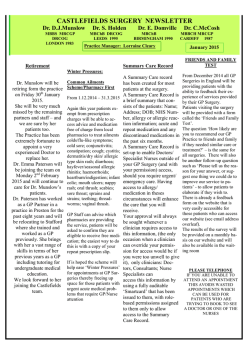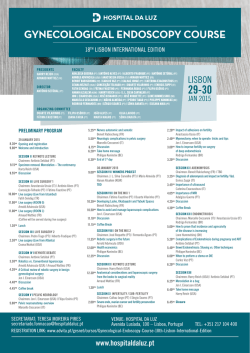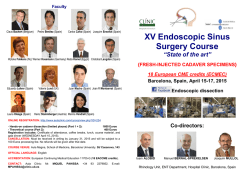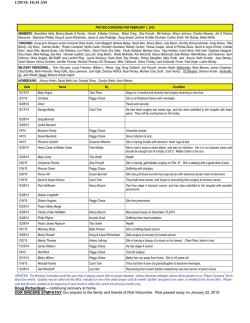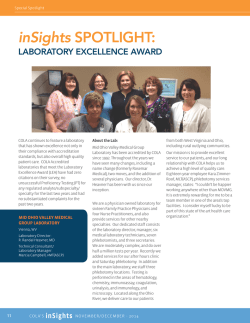
Full Text (PDF) - Anesthesiology and Pain Medicine
Anesth Pain Med. 2015 February; 5(1): e22846. DOI: 10.5812/aapm.22846 Research Article Published online 2015 February 1. The Effect of Intravenous Administration of Active Recombinant Factor VII on Postoperative Bleeding in Cardiac Valve Reoperations; A Randomized Clinical Trial 1 2 Narges Payani ; Mahnoosh Foroughi ; Ali Dabbagh 1,* 1Anesthesiology Research Center, Shahid Beheshti University of Medical Sciences, Tehran, Iran 2Cardiovascular Research Center, Shahid Beheshti University of Medical Sciences, Tehran, Iran *Corresponding author: Ali Dabbagh, Anesthesiology Research Center, Shahid Beheshti University of Medical Sciences, Tehran, Iran. Tel/Fax: +98-2122432572, E-mail: alidabbagh@ yahoo.com Received: September 24, 2014; Revised: November 15, 2014; Accepted: November 23, 2014 Background: Postoperative bleeding after cardiac reoperations is among the most complicating problems, both for the physicians and for the patients. Many modalities have been used to decrease its adverse effects and the need for blood products administration. Objectives: In a randomized double-blinded clinical trial of redo cardiac valve surgery in adult, the effect of active recombinant factor VII (rFVIIa) on postoperative bleeding was compared with placebo. Chest tube drainage was used for comparison of bleeding between the two groups. Patients and Methods: Two groups of 18 patients undergoing redo valve surgeries were treated and compared regarding chest tube drainage, need for blood products, prothrombin time (PT), partial thromboplastin time (PTT), hemoglobin and hematocrit, platelet count, and international normalized ratio (INR) in first 24 hours after surgery. Bleeding was assessed at 3rd, 12th, and 24th hour after operation. In rFVIIa group, 40 µg/kg of AryoSeven was administered before end of surgery and same volume of normal saline was administered as placebo in the control group. Results: Study groups showed no difference regarding baseline variables. Three patients in rFVIIa group (16.67%) and 13 in placebo group (72.23%) received blood products (P < 0.01). Chest tube blood drainage at 24th hour after operation was 315 ± 177 mL in rFVIIa group and 557 ± 168 mL in control group (P = 0.03). At third and 12th hour after operation, the difference was not statistically significant (P = 0.71 and P = 0.22, respectively). Postoperative ICU stay was not different; while extubation was longer in the placebo group (352 ± 57 vs. 287 ± 46 minutes; P = 0.003). Conclusions: Our study demonstrated the efficacy of rFVIIa in controlling postoperative bleeding in redo cardiac valve surgeries regarding subsequent blood loss and transfusion requirement; however, outcome results remains to be defined. Keywords:Postoperative Hemorrhage; Cardiac Surgical Procedure; Reoperation; Activated Recombinant Factor VII 1. Background Cardiac surgeries are among the most complicated surgical procedures worldwide with significant use of blood products. Postoperative bleeding and blood transfusion are among their major clinical challenges especially in redo surgeries. Therefore, we have to find more blood salvaging strategies. The cause of post-cardiac surgery bleeding can be either surgical or nonsurgical (1-4). Microvascular diffuse bleeding after cardiac surgery is still considered as an important and common problem leading to the use of antifibrinolytic drugs; however, the efficacy of these drugs is not always the same (1-10). Disturbances of the hemostatic system are more prominent in redo cardiac surgeries (6-9) including more consumption of blood products, which could be associated with significant morbidity and mortality. Hence, the effort to obtain safe and effective hemostatic condition can improve patient outcome (3, 4, 11-18). Among the many strategies to reduce blood transfusion, recently, active recombinant factor VII (rFVIIa) has been proposed (19-22). Some studies claimed it effective in reducing postoperative bleeding, e.g. in trauma patients (23-26). In cardiac surgery, although promising, rFVIIa is still "off-label" and not among FDA-approved indications, mandating more clinical trials (4, 14-29). One of the outcome measures for considering the efficacy of rFVIIa is to assess its use as a prophylactic agent (5, 28). However, there is not enough evidence to support prophylactic use of rFVIIa in cardiac surgery and its use still remains unclear, mandating randomized controlled trials to establish the efficacy of prophylactic rFVIIa in cardiac surgery (30). 2. Objectives In this randomized double-blinded clinical trial, we assessed the effect of using rFVIIa on the amount of postoperative bleeding in redo cardiac valve surgeries in adult patients. Copyright © 2015, Iranian Society of Regional Anesthesia and Pain Medicine (ISRAPM). This is an open-access article distributed under the terms of the Creative Commons Attribution-NonCommercial 4.0 International License (http://creativecommons.org/licenses/by-nc/4.0/) which permits copy and redistribute the material just in noncommercial usages, provided the original work is properly cited. Payani N et al. 3. Patients and Methods The study design and its clinical steps were approved by the Ethics Committee of Research Deputy of Shahid Beheshti University of Medical Sciences, Tehran, Iran. Afterwards, throughout the study, the participants entered the study after written informed consent was explained for them and read and signed by them. In this randomized double-blinded clinical trial, 36 patients entered the study during a 12-month period and randomly allocated to either "rFVIIa" or "placebo" groups. Randomization of the patients into two groups was done using randomization table. All the patients underwent redo cardiac valve surgery by the same surgeon. All participants were in the age range of 20 to 70 years and their redo operation included cardiopulmonary bypass. The following conditions were considered as exclusion criteria: - Underlying renal disease, - Underlying cerebral vascular disease, - Use of heparin or anti-platelet drugs up to the time of operation, - History of deep vein thrombosis, - Underlying hematologic disorders, - Any carotid plaque creating significant stenosis (i.e. stenosis > 75%), - Underlying pulmonary disorders affecting the spirometry indices significantly, and - Emergent or urgent surgery. To ensure the blinding process in administration of rFVIIa (AryoSeven, AryoGen Biopharma, Tehran, Iran) or placebo, a nurse in recovery room prepared the solution and brought it to operation room. Therefore, none of the colleagues was aware of the combination of the solutions. All the patients were visited the night before surgery by the same colleague. During this visit, the patients were informed of the study and its conditions and that they were free to leave the study due to any cause at any stage. The morning of the surgery day, the patients entered the study. The day of the operation and after entering the operating room, each patient was monitored by five-lead electrocardiography, pulse oximetry, invasive blood pressure monitoring through left radial artery, and cerebral oximetry. After inducing general anesthesia, central venous pressure was monitored through a right internal jugular central venous catheter (CVC). All the patients were anesthetized using a combination of 1 to 3 mg/kg of sodium thiopental, 5 µg/kg of fentanyl, and 0.2 mg/kg of cisatracurium. Laryngoscopy and intubation was performed after three minutes and endotracheal tube was fixed. All the patients were operated using the same technique including femoral cannulation for arterial and venous perfusion. Afterwards, with sternal opening, the adhesions were relieved and cardiopulmonary bypass was started after heparinization with 300 mg/kg of intravenous heparin, checked with an Activated Coagulation Time (ACT) > 480 seconds. After valve replacement 2 and closure of the cardiac chambers and gaining a nasal temperature of 36.5℃, weaning from cardiopulmonary bypass was performed. After stabilization of the hemodynamic status and full mechanical ventilation, weaning was gradually completed and heparin reversal was done with a full dose of protamine considering the heparin rebound effect. Surgical control of bleeding (including control of all suture lines for potential surgical bleeding) was done. At this time, the study drug was administered as the protocol: 40 µg/kg of rFVIIa as a 5-mL solution in rFVIIa group and 5 mL of sterile water in placebo group. Both solutions were administered through CVC line. Afterwards, the sternum was closed using steel wires. The patient was transferred to cardiac ICU and extubated after full recovery and hemodynamic stability. None of the patients in any of the groups received any systemic or topical hemostatic agent. Moreover, none of them received further or repeated doses of rFVIIa. The primary measured outcomes were the volume of postoperative bleeding, incidence of reoperation, blood transfusion, and potential thromboembolic events. Therefore, during the postoperative period, the following variables were monitored: volume of chest tube drainage; need for administration of blood products based on the study protocols for blood transfusion; prothrombin time (PT); partial thromboplastin time (PTT); hemoglobin and hematocrit; platelet count; and international normalized ratio (INR). All the above mentioned variables were monitored during the first 24 hours of surgery while bleeding was checked at third, 12th, and 24th hour after surgery. The patients were screened for thromboembolic events by physical examination of the entire body. All patients received blood and blood products after bleeding. A target hematocrit of 27% was maintained in the postoperative period. Indications for transfusion of fresh frozen plasma were INR > 1.5 or plasma activated PTT > 50 seconds; the indication for platelet transfusion was platelets < 100 × 109 cells/L. Heparin infusion was begun in all patients six hours after ICU entrance to preserve PTT around 60 seconds. Furthermore, transthoracic echocardiography was done for cardiac valve assessment in all patients. 3.1. Statistical Analysis Mean measures were compared using Student’s t test; P value < 0.05 was considered statistically significant; Chi square test was used to measure observed frequencies. SPSS 16 (SPSS Inc, Chicago, Illinois, the United States) was used for data entry and analysis. 4. Results The majority of our patients were female (63%) with a female to male ratio of 63:37; however, the two groups had no statistically significant difference regarding sex ratio. Mean age was 49.4 ± 16.1 years and mean weight was Anesth Pain Med. 2015;5(1):e22846 Payani N et al. 66.6 ± 10.9 kg. In addition, there was no statistical difference between the two groups regarding age and weight. The difference between the two groups regarding blood products transfusion was statistically significant; three patients in rFVIIa group needed blood products (16.67%) while 13 patients in the placebo group received blood products (72.23%) (P < 0.01). During the first three hours after surgery, mean chest tube blood drainage was 62.8 ± 8 mL in rFVIIa and 79.4 ± 12 mL in placebo groups (P = 0.71). During the first 12 hours after surgery, mean chest tube blood drainage was 160.6 ± 56 mL in rFVIIa and 293.3 ± 92 mL in placebo groups (P = 0.22). Finally, during the first 24 hours after surgery, mean chest tube blood drainage was 315 ± 177 mL in rFVIIa and 557 ± 168 mL in placebo groups (P = 0.03). The two groups were similar regarding mean of preoperative PT; however, mean of postoperative PT was significantly lower in rFVIIa group compared with the placebo group (13.8 ± 1.8 vs. 15.8 ± 3 seconds; P = 0.02). However, there was no statistically significant difference between two groups in mean of preoperative and postoperative PTT and INR. The mean of surgery preoperative platelet count was not statistically different between two groups; However, the mean of postoperative platelet count was higher in rFVIIa group compared with placebo group (5551 ± 875 vs. 4191 ± 856; P = 0.03). Nonetheless, there was no statistically significant difference between the two groups regarding the mean of preoperative and postoperative hematocrit or hemoglobin levels. Although two groups were similar regarding ICU stay, the mean time to extubation was longer in the placebo group compared with rFVIIa group (352 ± 57 vs. 287 ± 46 minutes; P = 0.003). No thromboembolic complications including potential central nervous system-related or deep venous embolic events were noticed during postoperative clinical follow-ups. 5. Discussion Postoperative bleeding after redo cardiac surgery is an important potential complication with resource utilization. Replacement of bleeding with blood products is associated with increased morbidity and mortality. Hence, any safe intervention to preserve hemostasis status without systemic activation of the coagulation cascade is appreciated. However, a substantial body of evidence has demonstrated a strong association between transfusion of blood and its products with adverse outcomes, leading us to a number of blood salvaging strategies for decreasing the need for extra blood transfusion. The results of this study demonstrated that administration of single dose of 40 µg/kg of intravenous rFVIIa in patients undergoing redo cardiac valve surgery could be effective in reducing the volume of postoperative chest tube drainage and need to blood transfusion, with no thromboembolic event. Prophylactic use of rFVIIa is suggested to be benefit in redo cardiac surgeries when the risk of coagulopathic bleeding and need for transfusion Anesth Pain Med. 2015;5(1):e22846 is high. In addition, some of the lab indices for coagulation were improved in the rFVIIa group. Thus far, prophylactic use of rFVIIa in redo cardiac valve surgery has not been assessed in prospective trails. At first, rFVIIa was approved for treating hemorrhagic events in hemophilic patients in 1999 and now its indications are extended to handle and even prevention of bleeding in a wide spectrum of surgical procedures (31). There is no consensus and guideline regarding dosage, time, or number of administration; therefore, physicians have individualized the decision on administrating rFVIIa in each patient (31, 32). In our study, the trend in the amount of bleeding measured as "chest tube drainage" demonstrated the difference between two groups increase by time. In one study, administration of rFVIIa could decrease bleeding in patients on extracorporeal membrane oxygenation (33). Therefore, the results of our study were in concordance with some other studies in which rFVIIa was used as a prophylactic agent, although none were in redo cardiac surgeries. In addition, as mentioned in other studies, rFVIIa could be used both as a prophylactic agent and as a "rescue therapy" in order to treat refractory bleeding; however, there are some controversies on that regard (1, 5, 10, 17, 18, 28, 29, 34-39). Gill et al. performed a randomized placebo-controlled trial in those with bleeding after cardiac surgery; they observed more critical adverse events in the rFVIIa groups (40 and 80 µg/kg) than in placebo group although it was statistically insignificant. They stated that some of patients in rFVIIa groups were older and had longer on-pump duration with more transfusions before randomization (40). von Heymann et al. used rFVIIa (60-80 µg/kg) as the last resort in 24 adults with refractory bleeding despite extensive use of blood products and medications after a median of 14 hour from surgery; they observed no additional efficacy over usual hemostatic therapy (41). It might be partly interpreted that early administration of drug could be more effective in hemostatic enhancement than it is used as the rescue treatment after optimal conventional methods. Some studies reported better outcome when it was given early in the course of blood loss in comparison to when it was administrated as salvage medication (42-47). In one cohort study, it was shown that in cardiac surgery, the response rate to control of bleeding and thromboembolic events were similar with either ≤ 40 µg/kg or ≥ 100 µg/kg doses (4, 48). The most concern on rFVIIa safety is potential to inappropriate clotting in coronary, grafts, and cerebral arteries; it looks to be dose dependent and higher in older subjects (5, 49). Reported thromboembolic complications after use of rFVIIa have been shown to be outside of the cardiac surgery setting; however, retrospective studies, and RCT studies failed to show increased rate of thromboembolic events in treated patients (50, 51). Roberts et al. in a study on the safety profile of rFVIIa across all specialties in over 400000 cases (mostly, patients with 3 Payani N et al. hemophilia) expressed the risk of serious adverse events to be < 1% (52). Chapman et al. retrospectively analyzed the safety profile and efficacy of rFVIIa used for bleeding following cardiac surgery in 236 patients and compared the results with that of 213 controls. Results showed a reduction in the requirement of additional blood products in rFVIIa group and no significant difference in the incidence in thromboembolic events or acute renal failure between two groups (53). Repeated cardiac surgeries pose high morbidity risks, e.g. bleeding needing aggressive replacement; however, sometimes rescue therapy is not effective, making the benefits of prophylactic rFVIIa more than its risks. According to the study of Karkouti et al. the benefits of using rFVIIa might outweigh its risks; Chapman et al. mentioned similar findings (53, 54). Although the prophylactic role of rFVIIa has not been determined in other studies (5, 30), our study demonstrated the efficacy of rFVIIa, in controlling postoperative bleeding in redo cardiac surgeries, predominantly by assessment of subsequent blood loss as determined by chest tube drainage and transfusion requirement. Therefore, it seems that rFVIIa is a potent agent in controlling postoperative bleeding in redo cardiac valve surgeries, especially when rFVIIa is used as a prophylactic agent. However, like other studies (55), we could not conclude whether rFVIIa could decrease mortality in our patients. Comparative studies of rFVIIa in adult cardiac surgery in nine separate studies had inconsistent outcomes in means of blood transfusion although most of them had retrospective design with a wide range of rFVIIa dosage (10-200 µg/kg). The similar finding was that patients had experienced major bleeding and required significant blood transfusion before administrating rFVIIa. Our study suggested that its prophylactic use was associated with less postoperative bleeding and transfusion requirement. In most studies on cardiac surgeries, rFVIIa was used after extensive use of blood products, aprotinin, and other antifibrinolytic agents was ineffective to stop bleeding. The massive blood transfusion and suboptimal hemodynamic status can increase the risk of myocardial infarction, stroke, and multiple end-organ failure. Hence, some of this concern might be related to critical patients’ condition. Indeed in patients with refractory life-threatening bleeding after failure of conventional hemostasis methods, any efforts might be worthless, mandating some more prophylactic methods including prophylactic use of rFVIIa (1, 2, 5, 20, 23, 44, 56). The administration of rFVIIa is considered as "not unreasonable for the management of intractable nonsurgical bleeding that is unresponsive to routine hemostatic therapy after cardiac procedures using CPB" based on the common Clinical Practice Guideline declared by The Society of Thoracic Surgeons and The Society of Cardiovascular Anesthesiologists in 2007 (57). Another finding of the study was decreased time for extubation in rFVIIa group, which could be related to the ef4 fects of increased blood products usage in control group. This finding could be attributable to the adverse effects of blood products on lung function (58-61). There is a general agreement to restrict blood transfusion in cardiac surgery; therefore, the benefits of rFVIIa might outweigh the risks, especially if it is given before the onset of vicious cycle of bleeding and transfusion (62). The cost and associated risks of both massive blood transfusion and reexploration seems to overweigh that of administrating rFVIIa alone (4, 23, 24, 39). Nevertheless, rFVIIa should be viewed as a life-saving agent not a complete replacement for other lifesaving medical or surgical interventions; in fact, but rFVIIa is a complement to the previous array for control of bleeding. The present study has some limitations that need to be considered. It was a small single-center study that could not individually reach to final decision and needed more complementary studies. This study did not assess the cost-effectiveness of rFVIIa. Moreover, because of budget limitations, this study did not measure the level of factor before its intravenous administration. We tried to modify confounding factors as much as possible while there might be some clinical variables such as cardiac or hepatic function that were not evaluated in our study. This study had some strength too. This study was a prospective, placebo-controlled, randomized trial included a homogeneous patient population who were at high risk of bleeding, and this allowed assessing the effectiveness of rFVIIa with greater precision. Moreover, the dosage and time of rFVIIa therapy were similar among all patients. The study was without intervention of other hemostatic agents; therefore, it could show the cause-effect relationship between rFVIIa and blood loss. The early administration of rFVIIa in the setting of redo cardiac surgeries could be an effective effort to decrease postoperative nonsurgical bleeding safely. Further studies with a large population of cardiac surgery patients are suggested to confirm its safety and efficacy. Acknowledgements The authors would like to acknowledge all kind cooperation of the physicians and nurses, Cardiac Surgery Operating Room, Cardiac Surgery Ward, and Cardiac ICU of Shaihd Modarres Hospital, Shahid Beheshti University of Medical Sciences, Tehran, Iran, for their kind assistance and impressive cooperation. Authors’ Contributions All authors contributed to study design, study performance, data analysis, manuscript preparation, and all other parts of study. Financial Disclosure The authors of this original manuscript disclosed that they had received the needed doses of recombinant factor VII as free samples from the manufacturer. ThereAnesth Pain Med. 2015;5(1):e22846 Payani N et al. fore, active Factor VII supply was supported by AryoGen Biopharma, Tehran, Iran, as recombinant Factor VII compound (AryoSeven). References 1. 2. 3. 4. 5. 6. 7. 8. 9. 10. 11. 12. 13. 14. 15. 16. 17. 18. 19. 20. Yank V, Tuohy CV, Logan AC, Bravata DM, Staudenmayer K, Eisenhut R, et al. Systematic review: benefits and harms of in-hospital use of recombinant factor VIIa for off-label indications. Ann Intern Med. 2011;154(8):529–40. Brown C, Joshi B, Faraday N, Shah A, Yuh D, Rade JJ, et al. Emergency cardiac surgery in patients with acute coronary syndromes: a review of the evidence and perioperative implications of medical and mechanical therapeutics. Anesth Analg. 2011;112(4):777–99. Clark KB, Kon ND, Hammon JW, Jr., MacGregor DA, Kincaid EH, Reichert MG. Factor IX complex for the treatment of severe bleeding after cardiac surgery. J Cardiovasc Pharmacol. 2013;62(1):67–71. Guzzetta NA, Russell IA, Williams GD. Review of the off-label use of recombinant activated factor VII in pediatric cardiac surgery patients. Anesth Analg. 2012;115(2):364–78. Levy JH, Sniecinski RM. Prohemostatic treatment in cardiac surgery. Semin Thromb Hemost. 2012;38(3):237–43. Vincent JL, Rossaint R, Riou B, Ozier Y, Zideman D, Spahn DR. Recommendations on the use of recombinant activated factor VII as an adjunctive treatment for massive bleeding--a European perspective. Crit Care. 2006;10(4):R120. Spinella PC, Perkins JG, McLaughlin DF, Niles SE, Grathwohl KW, Beekley AC, et al. The effect of recombinant activated factor VII on mortality in combat-related casualties with severe trauma and massive transfusion. J Trauma. 2008;64(2):286–93. Dabbagh A, Rajaei S, Bahadori Monfared A, Keramatinia AA, Omidi K. Cardiopulmonary Bypass, Inflammation and How to Defy it: Focus on Pharmacological Interventions. Iran J Pharm Res. 2012;11(3):705–14. Dabbagh A, Rajaei S, Shamsolahrar MH. The effect of intravenous magnesium sulfate on acute postoperative bleeding in elective coronary artery bypass surgery. J Perianesth Nurs. 2010;25(5):290– 5. Berkhof FF, Eikenboom JC. Efficacy of recombinant activated Factor VII in patients with massive uncontrolled bleeding: a retrospective observational analysis. Transfusion. 2009;49(3):570–7. Barnard J, Millner R. A review of topical hemostatic agents for use in cardiac surgery. Ann Thorac Surg. 2009;88(4):1377–83. Beckerman Z, Shopen Y, Alon H, Cohen O, Nir RR, Adler Z, et al. Coronary artery bypass grafting after aprotinin: are we doing better? J Thorac Cardiovasc Surg. 2013;145(1):243–8. Biancari F, Mikkola R, Heikkinen J, Lahtinen J, Airaksinen KE, Juvonen T. Estimating the risk of complications related to re-exploration for bleeding after adult cardiac surgery: a systematic review and meta-analysis. Eur J Cardiothorac Surg. 2012;41(1):50–5. Lee GC, Kicza AM, Liu KY, Nyman CB, Kaufman RM, Body SC. Does rotational thromboelastometry (ROTEM) improve prediction of bleeding after cardiac surgery? Anesth Analg. 2012;115(3):499– 506. Pasquali SK, Li JS, He X, Jacobs ML, O'Brien SM, Hall M, et al. Comparative analysis of antifibrinolytic medications in pediatric heart surgery. J Thorac Cardiovasc Surg. 2012;143(3):550–7. Vernick WJ, Woo JY. Anesthetic considerations during minimally invasive mitral valve surgery. Semin Cardiothorac Vasc Anesth. 2012;16(1):11–24. Ho KM, Litton E. Cost-effectiveness of using recombinant activated factor VII as an off-label rescue treatment for critical bleeding requiring massive transfusion. Transfusion. 2012;52(8):1696–702. Huang WY, Kruskall MS, Bauer KA, Uhl L, Shaz BH. The use of recombinant activated factor VII in three patients with central nervous system hemorrhages associated with factor VII deficiency. Transfusion. 2004;44(11):1562–6. Warren OJ, Alcock EM, Choong AM, Leff DR, Van Herzeele I, Darzi AW, et al. Recombinant activated factor VII: a solution to refractory haemorrhage in vascular surgery? Eur J Vasc Endovasc Surg. 2008;35(2):145–52. Pychynska-Pokorska M, Pagowska-Klimek I, Krajewski W, Moll JJ. Anesth Pain Med. 2015;5(1):e22846 21. 22. 23. 24. 25. 26. 27. 28. 29. 30. 31. 32. 33. 34. 35. 36. 37. 38. 39. Use of recombinant activated factor VII for controlling refractory postoperative bleeding in children undergoing cardiac surgery with cardiopulmonary bypass. J Cardiothorac Vasc Anesth. 2011;25(6):987–94. Dell'Amore A, Caroli G, Nizar A, Cassanelli N, Luciano G, Greco D, et al. Can topical application of tranexamic acid reduce blood loss in thoracic surgery? A prospective randomised double blind investigation. Heart Lung Circ. 2012;21(11):706–10. Jeganathan R, Armstrong S, Al-Alao B, David T. The risk and outcomes of reoperative tricuspid valve surgery. Ann Thorac Surg. 2013;95(1):119–24. Okonta KE, Edwin F, Falase B. Is recombinant activated factor VII effective in the treatment of excessive bleeding after paediatric cardiac surgery? Interact Cardiovasc Thorac Surg. 2012;15(4):690–4. Uber WE, Toole JM, Stroud MR, Haney JS, Lazarchick J, Crawford FA, Jr., et al. Administration of recombinant activated factor VII in the intensive care unit after complex cardiovascular surgery: clinical and economic outcomes. J Thorac Cardiovasc Surg. 2011;141(6):1469–77 e2. Diringer MN, Skolnick BE, Mayer SA, Steiner T, Davis SM, Brun NC, et al. Risk of thromboembolic events in controlled trials of rFVIIa in spontaneous intracerebral hemorrhage. Stroke. 2008;39(3):850–6. Yuan ZH, Jiang JK, Huang WD, Pan J, Zhu JY, Wang JZ. A meta-analysis of the efficacy and safety of recombinant activated factor VII for patients with acute intracerebral hemorrhage without hemophilia. J Clin Neurosci. 2010;17(6):685–93. Bauza G, Hirsch E, Burke P, Quillen K. Low-dose recombinant activated factor VII in massively transfused trauma patients with coagulopathy. Transfusion. 2007;47(4):749–51. Bhaskar B, Zeigenfuss M, Choudhary J, Fraser JF. Use of recombinant activated Factor VII for refractory after lung transplant bleeding as an effective strategy to restrict blood transfusion and associated complications. Transfusion. 2013;53(4):798–804. Boffard KD, Choong PI, Kluger Y, Riou B, Rizoli SB, Rossaint R, et al. The treatment of bleeding is to stop the bleeding! Treatment of trauma-related hemorrhage. Transfusion. 2009;49 Suppl 5:240S–7S. Levi M, Peters M, Buller HR. Efficacy and safety of recombinant factor VIIa for treatment of severe bleeding: a systematic review. Crit Care Med. 2005;33(4):883–90. O'Connell KA, Wood JJ, Wise RP, Lozier JN, Braun MM. Thromboembolic adverse events after use of recombinant human coagulation factor VIIa. JAMA. 2006;295(3):293–8. Johansson PI. Off-label use of recombinant factor VIIa for treatment of haemorrhage: results from randomized clinical trials. Vox Sang. 2008;95(1):1–7. Wittenstein B, Ng C, Ravn H, Goldman A. Recombinant factor VII for severe bleeding during extracorporeal membrane oxygenation following open heart surgery. Pediatr Crit Care Med. 2005;6(4):473–6. Benharash P, Bongard F, Putnam B. Use of recombinant factor VIIa for adjunctive hemorrhage control in trauma and surgical patients. Am Surg. 2005;71(9):776–80. Boffard KD, Riou B, Warren B, Choong PI, Rizoli S, Rossaint R, et al. Recombinant factor VIIa as adjunctive therapy for bleeding control in severely injured trauma patients: two parallel randomized, placebo-controlled, double-blind clinical trials. J Trauma. 2005;59(1):8–15. Clark AD, Gordon WC, Walker ID, Tait RC. 'Last-ditch' use of recombinant factor VIIa in patients with massive haemorrhage is ineffective. Vox Sang. 2004;86(2):120–4. Duchesne JC, Mathew KA, Marr AB, Pinsky MR, Barbeau JM, McSwain NE. Current evidence based guidelines for factor VIIa use in trauma: the good, the bad, and the ugly. Am Surg. 2008;74(12):1159–65. Stanworth SJ, Birchall J, Doree CJ, Hyde C. Recombinant factor VIIa for the prevention and treatment of bleeding in patients without haemophilia. Cochrane Database Syst Rev. 2007(2):CD005011. Simpson E, Lin Y, Stanworth S, Birchall J, Doree C, Hyde C. Recombinant factor VIIa for the prevention and treatment of bleeding in patients without haemophilia. Cochrane Database Syst Rev. 2012;3:CD005011. 5 Payani N et al. 40. 41. 42. 43. 44. 45. 46. 47. 48. 49. 50. 6 Gill R, Herbertson M, Vuylsteke A, Olsen PS, von Heymann C, Mythen M, et al. Safety and efficacy of recombinant activated factor VII: a randomized placebo-controlled trial in the setting of bleeding after cardiac surgery. Circulation. 2009;120(1):21–7. von Heymann C, Jonas S, Spies C, Wernecke KD, Ziemer S, Janssen D, et al. Recombinant activated factor VIIa for the treatment of bleeding in major abdominal surgery including vascular and urological surgery: a review and meta-analysis of published data. Crit Care. 2008;12(1):R14. von Heymann C, Hotz H, Konertz W, Kox WJ, Spies C. Successful treatment of refractory bleeding with recombinant factor VIIa after redo coronary artery bypass graft surgery. J Cardiothorac Vasc Anesth. 2002;16(5):615–6. von Heymann C, Redlich U, Jain U, Kastrup M, Schroeder T, Sander M, et al. Recombinant activated factor VII for refractory bleeding after cardiac surgery--a retrospective analysis of safety and efficacy. Crit Care Med. 2005;33(10):2241–6. von Heymann C, Schoenfeld H, Sander M, Ziemer S, Grubitzsch H, Spies C. Clopidogrel-related refractory bleeding after coronary artery bypass graft surgery: a rationale for the use of coagulation factor concentrates? Heart Surg Forum. 2005;8(1):E39–41. Diprose P, Herbertson MJ, O'Shaughnessy D, Gill RS. Activated recombinant factor VII after cardiopulmonary bypass reduces allogeneic transfusion in complex non-coronary cardiac surgery: randomized double-blind placebo-controlled pilot study. Br J Anaesth. 2005;95(5):596–602. Richardson A, Herbertson M, Gill R. The role of recombinant activated factor VII in cardiac surgery. HSR Proc Intensive Care Cardiovasc Anesth. 2009;1(3):9–12. Warren OJ, Rogers PL, Watret AL, de Wit KL, Darzi AW, Gill R, et al. Defining the role of recombinant activated factor VII in pediatric cardiac surgery: where should we go from here? Pediatr Crit Care Med. 2009;10(5):572–82. Hardy JF, Belisle S, Van der Linden P. Efficacy and safety of activated recombinant factor VII in cardiac surgical patients. Curr Opin Anaesthesiol. 2009;22(1):95–9. Levy JH, Tanaka KA. Prohemostatic agents to prevent perioperative blood loss. Semin Thromb Hemost. 2008;34(5):439–44. Ranucci M, Baryshnikova E, Colella D. Monitoring prohemostatic treatment in bleeding patients. Semin Thromb Hemost. 2012;38(3):282–91. 51. 52. 53. 54. 55. 56. 57. 58. 59. 60. 61. 62. Ranucci M, Isgro G, Soro G, Conti D, De Toffol B. Efficacy and safety of recombinant activated factor vii in major surgical procedures: systematic review and meta-analysis of randomized clinical trials. Arch Surg. 2008;143(3):296–304. Roberts HR, Monroe DM, 3rd, Hoffman M. Safety profile of recombinant factor VIIa. Semin Hematol. 2004;41(1 Suppl 1):101–8. Chapman AJ, Blount AL, Davis AT, Hooker RL. Recombinant factor VIIa (NovoSeven RT) use in high risk cardiac surgery. Eur J Cardiothorac Surg. 2011;40(6):1314–8. Karkouti K, Beattie WS, Crowther MA, Callum JL, Chun R, Fremes SE, et al. The role of recombinant factor VIIa in on-pump cardiac surgery: proceedings of the Canadian Consensus Conference. Can J Anaesth. 2007;54(7):573–82. Sattler S, Schwartz A. Does the use of recombinant factor VIIA reduce morbidity or mortality in nonhemophiliac patients? Ann Emerg Med. 2012;60(2):160–1. Porte RJ, Leebeek FW. Pharmacological strategies to decrease transfusion requirements in patients undergoing surgery. Drugs. 2002;62(15):2193–211. Society of Thoracic Surgeons Blood Conservation Guideline Task F, Ferraris VA, Ferraris SP, Saha SP, Hessel E2, Haan CK, et al. Perioperative blood transfusion and blood conservation in cardiac surgery: the Society of Thoracic Surgeons and The Society of Cardiovascular Anesthesiologists clinical practice guideline. Ann Thorac Surg. 2007;83(5 Suppl):S27–86. Vamvakas EC, Blajchman MA. Blood still kills: six strategies to further reduce allogeneic blood transfusion-related mortality. Transfus Med Rev. 2010;24(2):77–124. Vamvakas EC, Blajchman MA. Transfusion-related mortality: the ongoing risks of allogeneic blood transfusion and the available strategies for their prevention. Blood. 2009;113(15):3406–17. Vamvakas EC. Relative safety of pooled whole blood-derived versus single-donor (apheresis) platelets in the United States: a systematic review of disparate risks. Transfusion. 2009;49(12):2743–58. Vamvakas EC. Reasons for moving toward a patient-centric paradigm of clinical transfusion medicine practice. Transfusion. 2013;53(4):888–901. Tayebi Meybodi K, Taghvaei M, Derakhshanrad N, Khan ZH, Saberi H. Recombinant Activated Factor VII, as a Remedy for Intractable Coagulopathy Following Massive Transfusion in a Case of Giant Cranial Neurofibroma. Arch Neurosci. 2014;2(2). Anesth Pain Med. 2015;5(1):e22846
© Copyright 2025

